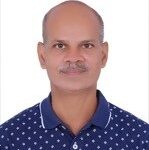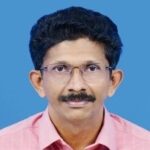Special Sessions
IEEE SPace, Aerospace and defenCE Conference, 2025 (SPACE 2025)
Launch Vehicle Technologies

GD, CGDG, VSSC

GD, CASG, VSSC

GD, RFSG/AVN, VSSC

EPG, VSSC
Abstract
- Guidance & Control of Launch Vehicles and STS: Dr. Gopal Jee, GD, CGDG, VSSC
- Actuators Sensors and Robotics for Space Applications: Dr. Biju Prasad B, GD, CASG, VSSC
- RF Systems for Launch Vehicles: Shri. Lal M J, Group Director, RFSG/AVN, VSSC
- Avionics Fabrication Techniques: Smt. Sheena Abraham, Group Director, EPG, VSSC
- Guidance & Control of Launch Vehicles and STS:
Reusable launch vehicle (RLV) is being developed by ISRO, where it is envisaged to recover both booster and upper stage of a space transportation system (STS). Booster is recovered using propulsion system whereas upper stage recovery is assisted by aerodynamics along with propulsion system. Guidance and control are the two essential components of onboard software which provides complete autonomy to the reusable launch vehicle. Guidance is the path planner algorithm, ensuring RLV’s safe ascent to the orbit, de-boost, re-entry and landing on a runway. Control works as an autopilot, ensuring the safety of the vehicle while steering it towards the targeted location decided by the guidance algorithm. To get complete reusability, various experimental flights are being carried out by us. We have achieved the mastery in launching the RLV to high altitude (HEX mission – Hypersonic re-entry experiment) using booster, landing it on a runway (LEX experiment – Landing experiment). Capability of taking the RLV to the orbit and re-entering into the Earth’s atmosphere (OREX – orbital re-entry experiment), without violating structural and thermal loads is being developed. Pinpoint landing of the booster is planned in near future. Brief description of plant modelling of rotational and translational dynamics, autopilot and guidance design will be covered in this talk. Glimpse of experiences gained during the journey of development of RLV will be given during the presentation. - Actuators Sensors and Robotics for Space Applications:
Actuators are used for the control and guidance in satellite launch vehicles. This can be achieved through thrust vector control by deflecting the liquid engine and solid motor nozzles, injecting high density fluid into the supersonic exhaust jet or deflecting the external fins during the aerodynamic phase of the mission. Actuators are also used to control the mixture ratio of fuel and oxidiser to maintain optimum propellant outage or alter the engine thrust. Since these are mission critical operations, a very high level of reliability and fault tolerance is required. This is achieved by introducing redundancy in its critical elements and maintaining a rugged fault detection isolation and reconfiguration system. Space robotics is a niche area which finds lot of application in interplanetary exploration, unmanned missions of orbital vehicles and in space stations for repair, maintenance and conducting experiments. These robotic systems should not only be designed to survive launch loads and harsh environments expected in space and interplanetary missions but also possess artificial intelligence to respond to unseen situations. In space stations, humanoids can conduct series of experiments and assist in cargo transfer and maintenance operations. With the tremendous advancements happening in AI ML area, space robotics has the potential to accelerate space exploration without risking the human life.
- RF Systems for Launch Vehicles:
RF Systems in Launch Vehicles can be grouped into Telemetry, Tracking and Tele-command systems. Functional requirement of telemetry systems is to acquire telemetry data pertaining to the vehicle performance and satellite injection parameters. All launch vehicles are inherently explosion prone whenever they contain fuel or oxidizer, or explosive devices are installed, or toxic chemicals or high-pressure gasses are on board. There is requirement to track all rocket systems during their ascent from the ground to low earth orbit, and terminating any flight before it poses a hazard to lives or property. Tracking and Tele-Command System forms an important part of System for terminating the flight for Range Safety. Vehicle instantaneous position should be known with high accuracy in real -time. Based on tracking data, coded sequence should be sent to launch vehicle, decoded onboard for command execution as per the issued command from the ground. The position of launch vehicle can be computed using either Radar Tracking, Inertial Navigation System or GPS/NaViC Based systems. Radar tracking is an independent system. Data from Inertial Navigation System or NaVIC system is collected though launch vehicle Telemetry.
- Avionics Fabrication Techniques:
Avionics package Life Cycle starts with Launch Vehicle Project Requirements. Based on mutual discussion and compromise between Design team and Project team, Conceptual design will be made. Specifications will be generated and preliminary design will be arrived at block diagram level. The preliminary design has to undergo all reviews and once the circuit is finalized, Printed Circuit Board (PCB) layout design is made. After getting clearance for all design as well as Quality Control aspects, the PCB will be fabricated. The inputs for the fabrication of Avionics packages are Components, PCBs and Mechanical chassis. The PCB will be wired with components or electronic parts by means of Reflow soldering operation and Manual soldering. After wiring the card is ready for testing. It will undergo all testing to check whether the original specifications whatever aimed is met and whether all project requirements are met. The different tests are Initial Standard Room Conditions Test (ISRC), Thermal tests (Hot and Cold soak), Vibration, Shock EMI, Vacuum test, Final Standard Room Conditions Test (FSRC. There are two tpes of tests like Qualification tests to establish design margin and Flight acceptance tests to bring out workmanship defects. After obtaining all clearances, a Configuration Controlled Document (CCD) will be released. There is an approved CCD for each package. Once the package fabrication and testing is streamlined, the production can be outsourced to external industries after accreditation and proper enabling. Electronic devices are shrinking in size and increasing in complexity due to improvements in VLSI technology. Miniaturized Avionics packages are the need of the hour for space applications. For that miniaturization technologies like Hybrid Microcircuit technology, Surface Mount Technology and 3D packaging technologies are used. All these will be addressed briefly in the presentation along with some case studies.
Bio-sketch for Speakers:

GD, CGDG, VSSC
Dr. Gopal Jee joined as scientist/engineer ‘SC’ at Vikram Sarabhai Space Centre, ISRO in June 1999. Currently he is holding the post of Group Director of Control and Guidance Design Group (CGDG) of CGSE entity. He graduated from National Institute of Technology (MNREC), Allahabad, India in 1997. Then he did Post-Graduation from Indian Institute of Technology, Delhi, India in Control Engineering and Instrumentation. He completed PhD in Department of Aerospace Engineering, Indian Institute of Technology, Bombay in 2010. His main area of work is Flight control law design for various launch vehicles including Reusable Launch Vehicle (RLV). He mainly contributed for the autopilot design of reusable launch vehicle, crew module control and test vehicle control for testing crew escape system. He won ISRO’s young scientists merit award for the year 2007 in appreciation of his contribution to the Indian space program in launch vehicle avionics area. He also won a few best paper awards in various international conferences. He has two journal publications and about 43 conference papers to his credit and is a reviewer of many international journals. He is a life member of Systems Society of India, Aeronautical Society of India and Indian Society of Systems for Science and Engineering. His current research interests are in Control law design for air-breathing propulsion system and Integrated guidance and control law design for reusable launch vehicles.

GD, CASG, VSSC
BIJU PRASAD B obtained his PhD in Mechanical Engineering from CUSAT, M.E. in Aerospace Engineering from Indian Institute of Science, Bangalore and B-Tech in Mechanical Engineering from College of Engg. Trivandrum, University of Kerala. Presently he is Scientist/Engineer ‘G’, and Group Director, Control Actuation Systems Group, ESAE, VSSC ISRO. He joined VSSC in 1995 and worked in the design and development of Fault tolerant Actuators and sensors for the thrust vector control system and mixture ratio control system of satellite launch vehicles such as LVM3, HRLV, PSLV, SSLV, RLV and Gaganyaan (manned mission), Landing Gear systems for Reusable Launch Vehicles, Robotic systems for space application. He is also, Associate Project Director, RLV ORV (Landing gear systems) and Deputy Project Director, LVM3 (Control systems). He holds one patent on linear electromechanical actuator. He is a recipient of team excellence award for the development of LVM3. His Areas of interest include Fault Tolerant Actuators, Mechanisms and Robotics.

GD, RFSG/AVN, VSSC
Lal M J, Scientist/Engineer G is Presently holding the post of Group Director, RF Systems Group, Avionics Entity, VSSC. He Has 33 years of experience in Instrumentation, Development of Data Acquisition Systems, Development RF Systems and Project Management. He Graduated in Electronics and Communication from University of Kerala in 1991. He Joined Vikram Sarabhai Space Centre in 1992 as Test Engineer in Integrated Structural Dynamic Test Facility, Structures Entity. He completed his Post graduation in Telecommunication from Indian Institute of Science in 2001. He Worked in RF Systems area 2001-2017 and Moved over to core PSLV Project as Deputy Project Director, Electrical Integration and Checkout Systems in 2017. He was Associate Project Director of PSLV 2019-2023 and Vehicle Director, PSLV-C57/Aditya-L1 Mission.

EPG, VSSC
Sheena Abraham, Scientist/Engineer ‘G’ from Vikram Sarabhai Space Centre is the Group Director of Electronics Production Group of Electronics Systems and Actuators entity. She took her BTech in Electronics and Communication from College of Engineering, Trivandrum in 1994 and MTech in Electronics Design and Technology from Indian Institute of Science, Bangalore. She joined VSSC in 1995 and has 30 years of experience in different fields like design and miniaturization of sensors, design and development of Data Acquisition systems, development of miniaturization technologies, production of Avionics Packages. She has developed advanced and miniaturized sensors like MEMS Acoustic sensor, MEMS based Smart Pressure Sensor, Piezoelectric Vibration Sensor and MEMS Rate Sensors. The sensors developed by her have flown in different Launch Vehicles. The MEMS acoustic sensor developed by her is the first indigenously developed MEMS sensor to be flight tested in an Indian Launch Vehicle. A patent has been granted for her invention “MEMS based sensor for measuring acoustic pressure”. She has also contributed a lot in the area of Electronic Packaging technologies like Hybrid Micro circuits and Surface Mount Technology. She has set up and qualified a SMT Machine soldering line in VSSC for the reflow soldering of all Avionics Surface Mount assemblies. She is at present responsible for the realization of Avionics packages for all operational Launch Vehicles like PSLV, GSLV, LVM3 and development vehicles including Gaganayaan through external industries as well as through in-house facilities. She has taken a lead role in enabling many external industries for the production of Avionics Packages to meet ISRO launch manifesto. She has been awarded ISRO Team award in the year 2017 for “PSLV C37 with 104 Satellites-Multi satellite integration mission operation”. She has won the Institution of Electronics and Telecommunication Engineers (IETE) B V Baliga Memorial Award 2020 for her outstanding contribution in the field of Electronics & Telecommunication with emphasis on R&D and industrial development during the past 10 years. She is a Fellow of IETE.